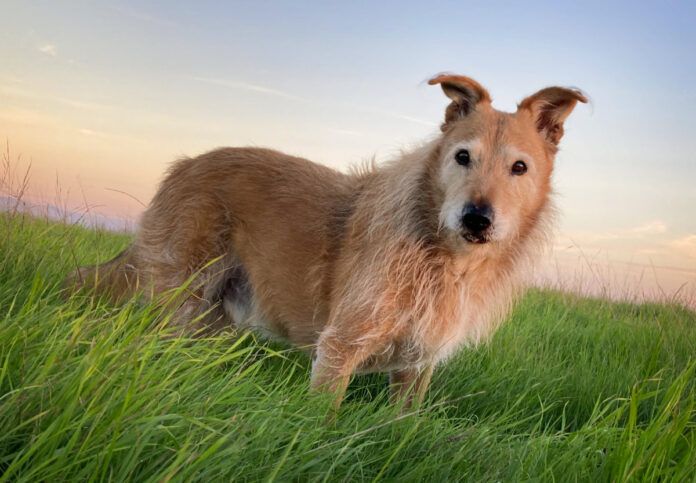My just-turned 14-year-old dog Otto has lost most of his hearing. Our communication is very limited now. He can no longer hear me tell him what a good dog he is or how much I love him. True, I can shout these things at him, and speak them right into his adorably fuzzy ears, but a loving tone just isn’t the same when you have to raise your voice, or someone is speaking to you with their lips on your head! But thank goodness we have hand signals so I can help him understand what I want him to do.

He can still hear the loudest of handclaps, and this is what I still use to get his attention when I need him to look at me – we won’t discuss how much these claps tend to make my husband jump out of his skin and swear under his breath. When I clap loudly enough, Otto will look at me for information. Then I can signal, “Stay!” with a crossing guard’s “stop” gesture; this now means everything from, “Don’t try to follow me outside, you’re not coming with me to the store,” to “Wait there for a second, I have to run back inside to get my coat.” (I’ve started using the “stay” signal followed by holding up my index finger in a “We’re number one!” gesture to mean something more like our old verbal “wait” cue.)

He’s always been rock-solid on the hand signals for “sit” and “down” and “stand” – but I honestly don’t ask him to do these behaviors much anymore. His arthritis makes it increasingly difficult to stand up from a down and to lower himself into a sit. Now he gets treats just for showing up and standing with us attentively when I ask my younger dog to sit, down, and stand. He likes that a lot!
I never really taught him a hand signal for “Come.” My cue has always been a verbal “Here!” or a whistle. That was a bad oversight, because “come to me” is something I ask him to do many times a day, especially now that it’s cold and I no longer leave doors open for him to come into my office or into the house whenever he gets around to it. Sometimes he stands outside 50 yards away, trying to decide if he’s going to hang out outside (he’s got the run of our fenced two acres) or follow me into my warm office. I stand in my office doorway grumbling. “All the heat is escaping! What are you going to do?” So I’ve started teaching him a physical recall cue. Spontaneously, it turned into something a bit theatrical. I reach my arms out toward him, and then pull them back to my chest, like an endangered woman in a silent film, imploring the hero to come back and save her. It looks a little silly, but he can see it from a good distance away, and he’s picked it up quickly.

I’ve long used a “thumbs up” gesture as an alternative to a click or “Yes!” to mark the moment he does a behavior I’ve cued or, to be honest, anything else that I like. I’m so grateful that I taught him that alternative to ”Yes!” because, basically, in my eyes, he can’t do anything “wrong” anymore. He’s always a good boy, and I give him the “thumbs up” and a big smile many times a day. Again, thank goodness he knows that one, because it’s one of the few things I can do now to make his “concentrating” expression soften and his tail wag.
Don’t wait until it’s too late to teach your dog hand signals – if for no other reason than as a hedge for his or her old age. You can thank me later.
Here are just a few of the many articles we’ve done on teaching hand signals for your cues:
How to Train Hearing Impaired Dogs Using Hand Signals and Simple Gestures
Dog Training With Hand Signals
Special Needs Training: Training Dogs with Hand Signals







With our current girl, I mostly just use the hand signals for wait and come. Although maybe I’ll start using hand signals for other things. She just turned 13 and celebrated her 7th “Gotcha Day” – adopted her the day after she turned 6. (She had a fabulous first home but her owner had to go to a nursing home.)
I’m 67 and still pretty healthy but am looking at a point when I may have to move to a senior living situation. Most don’t like big dogs and Diana pawPrints is 100 lbs and Freyja is 50 lbs although she gives the impression of smaller. But she is also mostly Husky and they usually don’t like Spitz breeds either. So if I move it won’t be until both have crossed the rainbow bridge. I’ll pay for home care if I have to so I can stay and my dogs can stay with me.
I have always worked my dogs with hand signals and gestures, but for the opposite reason. I often come down with respiratory issues and lose my voice for up to a week at a time. I wanted to have my dogs trained to signals and sounds that I could make without a voice. I will have to think about how that will work with them as they lose their hearing. I guess there really isn’t a good solution on how to call them in after dark in that case but everything else should carry over. Thank you for the article!
Blinking flashlight at night would work for recall?
I work with Great Dane (and Irish Wolfhound) rescue. We’ve taken in a number of deaf Danes. We rely entirely on hand signals for the deaf Danes. We’ve taken in one Dane that was totally deaf and totally blind. We found him a super home and he just blossomed. His owner communicated with him via touch only. We had a Dane of our own that was completely blind and deaf in one ear. We used a lot of touch to communicate with her, as well. It was interesting that if out blind/deaf in one ear girl was in the yard and we called her, she would often run AWAY from us. Not because she was “bad”, not because she didn’t know her recall. She couldn’t tell where the sound was coming from and not being able to see us, she didn’t know which way to go. We just went and got her. As we approached her, we would “stomp” our feet so she could feel the vibrations and know someone was approaching her and wasn’t startled when we touched her.
Living with a movement-sensitive Basenji, I use hand signals about half the time, but use them a lot when we are in distracting environments or when I need him to focus on what we’re doing rather than what’s going on around him. As a dog trainer, I teach hand signals first, then add verbal cues later. With hearing impaired dogs I use hand signals Nancy mentioned; thumbs up for praise, hand flash as reward marker yes, etc. and also use scent and light touch for getting a dog’s attention without startling him/her.
When I first starting training our English lab I incorporated hand signals. She is now 5 and knows she must always look at me for a verbal or a hand command even outside off lead! She has a boundary of approximately 20’ off lead and always looks back to check in. I thought it important for hand signals in case I wanted to give her a silent command.
Agree with everything you said (been there and done that quite a bit in the past), but mostly commenting on what a lovely article this was. Your love for Otto comes through so loud and clear. He is a very lucky dog to have such a special owner, though I’m sure you think you’re the lucky one! Thank you, this was so nice to read first thing this morning.
Years ago I used hand signals with verbal cues without realizing how well my aging Pug Kohla grasped the concept. One day, our chickens got loose in the yard, and Kohla was on the opposite side of them. Not expecting much I halted, turned her her and got her moving again, and she caught on very quickly.. we herded those chickens back into their pen like we’d been doing it for years! I am still amazed…. I herded chickens with a Pug!
When my first Corgi began to lose her hearing in her teen years, I started using hand signals and, being a very smart girl, she caught on quickly. I have since incorporated hand and vocal signals at the same time with the subsequent loves of my life, no matter their age. It’s so hard for us, thinking that we’ve stopped talking to them, because they can no longer hear our voices. But with eye contact (sometimes limited) and lots of touching throughout their lives, we can all overcome these obstacles. ❤️
Ramses was hard of hearing but never went deaf so he heard me to his last breath. But it did motivate me to start hand signals with training for Diana and now Freyja. They’ve been minimal so far. Diana can sit, lay and stand with a signal. Freyja has a come, not quite as dramatic as yours, but similar. Now I need to teach Diana the come and Freyja the sit, down and stand. Well, she pops up pretty fast so stand may be more difficult. She knew nothing when I got her and can sit nicely now, at least for a few seconds. As a more than 50% Husky I may never completely succeed with her verbally let alone with hand signals. But Diana is pretty compliant especially when hot dogs, cheese or chicken are involved. I’ve never succeeded with clicker training, my fault not theirs. It’s a coordination problems. So it’s verbal and hand signals.
What an important and informative article! As an Obedience competitor, I’ve always trained my dogs to respond to hand signals. Over time, I’ve learned to add to our non-verbal vocabulary in preparation for a dog’s aging years, and it has proven invaluable and enhanced our relationship. I’ve started to add a variety of physical touches for basic words just in case my current boy’s sight deteriorates as he gets older – he enjoys the additional physical contact and it’s another way to keep his mind active. (I like Leslie’s use of scent – I imagine that can be very useful with a dog with diminishing sight and hearing!)
I think it is wonderful how you are giving folks some tips on dealing with deaf dogs. I have two out of seven at the moment. The eleven year old Standard Poodle does pretty well with hand gestures. The fifteen and a half year old Havanese not so well as she also has dementia. Every day with her is a gift now and fortunately we retired several years ago so I can pay close attention to her most of the time.
Lovely article Nancy dear! My Weston of very blessed memory and who lost her hearing late in her almost 20 years was so attentive to hand signals….but was at times a most stubborn ‘scot’! She could at times be selective as to action taken! I love reading about you and your loved ones! Good health and happiness to all of them! Seasons greetings Lorraine Glogauer
Westie
My girl reached the ripe age of 15. I started hand signals when she was a puppy because I knew of course she would age and lose her hearing eventually. Most important was recall to bring her inside. I brought my fingers towards me with my palm up.
I also used hand signals for my guy thinking that very thing for when he got older and he would lose his hearing and then he started getting cataracts in his eye and I thought oh goodness the hand signals aren’t going to help him if he can’t see. We would use a hand signal to come bending it towards us if he was facing the other way and he was close by we would tap him on his body and he would turn and then we would use the hand signal. He always responded very well I used one early on when he was about 5 and I would pat the top of my head and that with me asking him if he wanted a special treat, without using words. He knew it because he would always start barking when I did that. I miss him so much. He passed away last year being over 18 and I had him for over 17 years. Bear was a very good boy.
My heart goes out to you Karen. So hard to lose our beloved friends.
When we had Little Old Sammie (who lived long enough to be technically both blind and deaf) we used touch to communicate.
Bless his little heart 🙁
I’ve always used hand signals for puppies, along with verbal under the idea that hand signals would be easier to learn than verbal language. I now have a 12 year old lab rescue who doesn’t seem to hear a sound but does seem to respond to my hand and body signals. The young woman who gave him up to me was disconcerted by his always watching her, not realizing that he was probably watching for signals.
My standard poodle is 10 months. He knows a lot of commands. However, I would like to speak less; so I use hand commands and gestures. I find this works best for both us. I feel less stressed as well. The constant sit, stand, no, wait, leave, up, down etc. was a bit much.